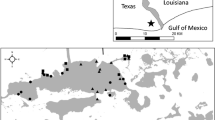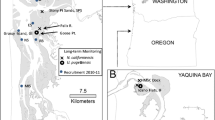Abstract
Florida Bay exhibits highly dynamic hydrographic regimes that influence variability in the retention, survivorship, and migration of pink shrimp,Farfantepenaeus duorarum, larvae and juveniles. Florida Bay is the nursery habitat for pink shrimp and since a large fishery is based on the adult population in the Dry Tortugas region, Florida Bay plays a fundamental role in the health of the pink shrimp fishery in South Florida. Conversely, the level of shrimp recruitment to the fishery can act as an indicator of the health of Florida Bay integrating multiple biological, physical, and environmental variables. We examined 372 mo of data on commercial landings of pink shrimp to estimate monthly recruitment. We found recruitment occurs throughout the year, there are one or more seasonal peaks, and the magnitude and monthly position of the peaks changed through decades. These changes may be explained by a varying spawning population producing different levels of eggs, by environmental changes in the nursery grounds that modulate a nearly constant supply of eggs, or a combination of these. Recruitment estimates and the residuals about stock-recruitment relationships were compared over three decades (1965–1995) in terms of annual and monthly trends and average patterns. Significant differences found between the decades could be due to ecological changes in Florida Bay, specifically to loss of recruitment peaks, with an associated overall decline in pink shrimp recruitment. For the lates years of the study, recruitment and residuals about the stock-recruitment curve are increasing, which may indicate an improvement in Florida Bay as a nursery ground for pink shrimp, and thus as habitat for other organisms as well.
Similar content being viewed by others
Literature Cited
Allen, D. M., J. H. Hudson, andT. J. Costello. 1980. Postlarval shrimp (Penaeus) in the Florida Keys, species size and seasonality.Bulletin of Marine Science 30:21–33.
Braaten, D. O. 1969. Robustness of the DeLury population estimator.Journal of the Fisheries Research Board of Canada 26:339–355.
Browder, J. A. 1985. Relationship between pink shrimp production on the Tortugas grounds and water flow patterns in the Florida Everglades.Bulletin of Marine Science 37:839–856.
Chen, Y.-H. andR. E. Condrey. 1985. A modification of the DeLury method for use when natural mortality is not negligible.Fisheries Research 3:23–28.
Costello, T. J. andD. M. Allen. 1960. Notes on the migration and growth of pink shrimp,Penaeus duorarum. Procedings of the Gulf and Caribbean Fisheries Research Institute, Twelfth Annual Session, November 1959:5–9. University of Miami, Miami, Florida.
Costello, T. J. andD. M. Allen 1965. Migrations and geographic distribution of pink shrimp,Penaeus duorarum, of the Tortugas and Sanibel grounds, Florida.Fishery Bulletin 65:449–459.
Costello, T. J., M. M. Allen, andJ. H. Hudson. 1986. Distribution, seasonal abundance, and ecology of juvenile northern pink shrimp,Penaeus duorarum, in the Florida Bay area. National Oceanic and Atmospheric Administration Technical memorandum NMFS-SEFC-161, June 1986. United States Department of Commerce. Miami, Florida.
Criales, M. M. andT. N. Lee. 1995. Larval distribution and transport of penaeoid shrimps during the presence of the Tortugas Gyre in May–June 1991.Fishery Bulletin 93:471–482.
Cummings, W. C. 1961. Maturation and spawning of the pink shrimp,Penaeus duorarum Burkenroad.Transactions of the American Fisheries Society 90:462–468.
DeLury, D. B. 1947. On the estimation of biological populations.Biometrics 3:145–167.
Ehrhardt, N. M. andC. M. Legault. 1996. Crustacean stock assessment techniques incorporating uncertainty. Report of the FAO/CFRAMP Stock Assessment Workshop. Port of Spain, Trinidad and Tobago. January 8–12. 1996. Food and Agricultural Organization Fisheries Report No. 544. Food and Agricultural Organization, Rome.
Ewald, J. J. 1965. The laboratory rearing of pink shrimp,Penaeus duorarum Burkenroad.Bulletin of Marine Science 15:436–449.
Heck, K. L. andG. S. Wetstone. 1977. Habitat complexity and invertebrate species richness and abundance in tropical seagrass meadows.Journal of Biogeography 4:135–142.
Hettler, W. F. 1992. Correlation of winter temperature and landings of pink shrimpPenaeus duorarum, in North Carolina.Fishery Bulletin 90:405–406.
Hettler, W. F. andA. J. Chester. 1982. The relationships of winter temperature and spring landings of pinks shrimp,Penaeus duorarum, in North Carolina.Fishery Bulletin 80:761–768.
Hilborn, R. andC. J. Walters. 1992. Quantitative Fisheries Stock Assessment: Choice, Dynamics and Uncertainty. Chapman and Hall, New York.
Jones, A. C., D. E. Dimitriou, J. J. Ewald, andJ. H. Tweedy. 1970. Distribution and early developmental stages of pinks shrimp,Penaeus duorarum, in Florida waters.Bulletin of Marine Science 20:634–661.
Lee, T. N., M. E. Clarke, E. Williams, A. F. Szmant, andT. Berger. 1994. Evolution of the Tortugas Gyre and its influence on recruitment in the Florida Keys.Bulletin of Marine Science 54:621–646.
Munro, J. L., A. C. Jones, andD. Dimitriou 1968. Abundance and distribution of the larvae of the pink shrimp (Penaeus duorarum) on the Tortugas shelf of Florida, August 1962–October 1964.Fishery Bulletin 67:165–181.
Perez-Farfante, I. 1969. Western Atlantic shrimps of the genusPenaeus.Fishery Bulletin 67:461–591.
Ricker, W. E. 1954. Stock and recruitment.Journal of the Fisheries Research Board of Canada 11:559–623.
Roessler, M. A. andR. G. Rehrer. 1971. Relation of catches of postlarval pink shrimp in Everglades National Park, Florida, to the commercial catches on the Tortugas grounds.Bulletin of Marine Science 21:790–805.
Sheridan, P. F. 1996. Forecasting the fishery for pink shrimp,Penaeus duorarum, on the Tortugas grounds, Florida.Fishery Bulletin 94:743–755.
Tabb, D. C., D. L. Dubrow, andA. E. Jones. 1962. Studies on the biology of the pink shrimpPenaeus duorarum Burkenroad, in Everglades National Park, Florida.Florida State Board of Conservation, University of Miami Marine Laboratory, Technical Series 37:1–30.
Upton, H. F., P. Hoar, andM. Upton. 1992. The Gulf of Mexico Shrimp Fishery: Profile of a Valuable National Resource. Center for Marine Conservation, Washington, D. C.
Williams, A. B. 1955. A contribution to the life histories of commercial shrimps (Penaeidae) in North Carolina.Bulletin of Marine Science 5:116–146.
Williams, A. B. 1969. Penaied shrimp catch and heat summation, an apparent relationship. Food and Agricultural Organization Fisheries Report 57:647–656.
Yokel, B. J., E. S. Iversen, andC. P. Idyll 1964. Prediction of the success of commercial shrimp fishing on the Tortugas Grounds based on enumeration of emigrants from the Everglades National Park estuary. Food and Agricultural Organization World Scientific Conference on the Biology and Culture of Shrimps and Prawns.Experience Paper 60:1–6.
Author information
Authors and Affiliations
Corresponding author
Rights and permissions
About this article
Cite this article
Ehrhardt, N.M., Legault, C.M. Pink shrimp,Farfantepenaeus duorarum,recruitment variability as an indicator of Florida Bay dynamics. Estuaries 22, 471–483 (1999). https://doi.org/10.2307/1353212
Received:
Accepted:
Issue Date:
DOI: https://doi.org/10.2307/1353212




